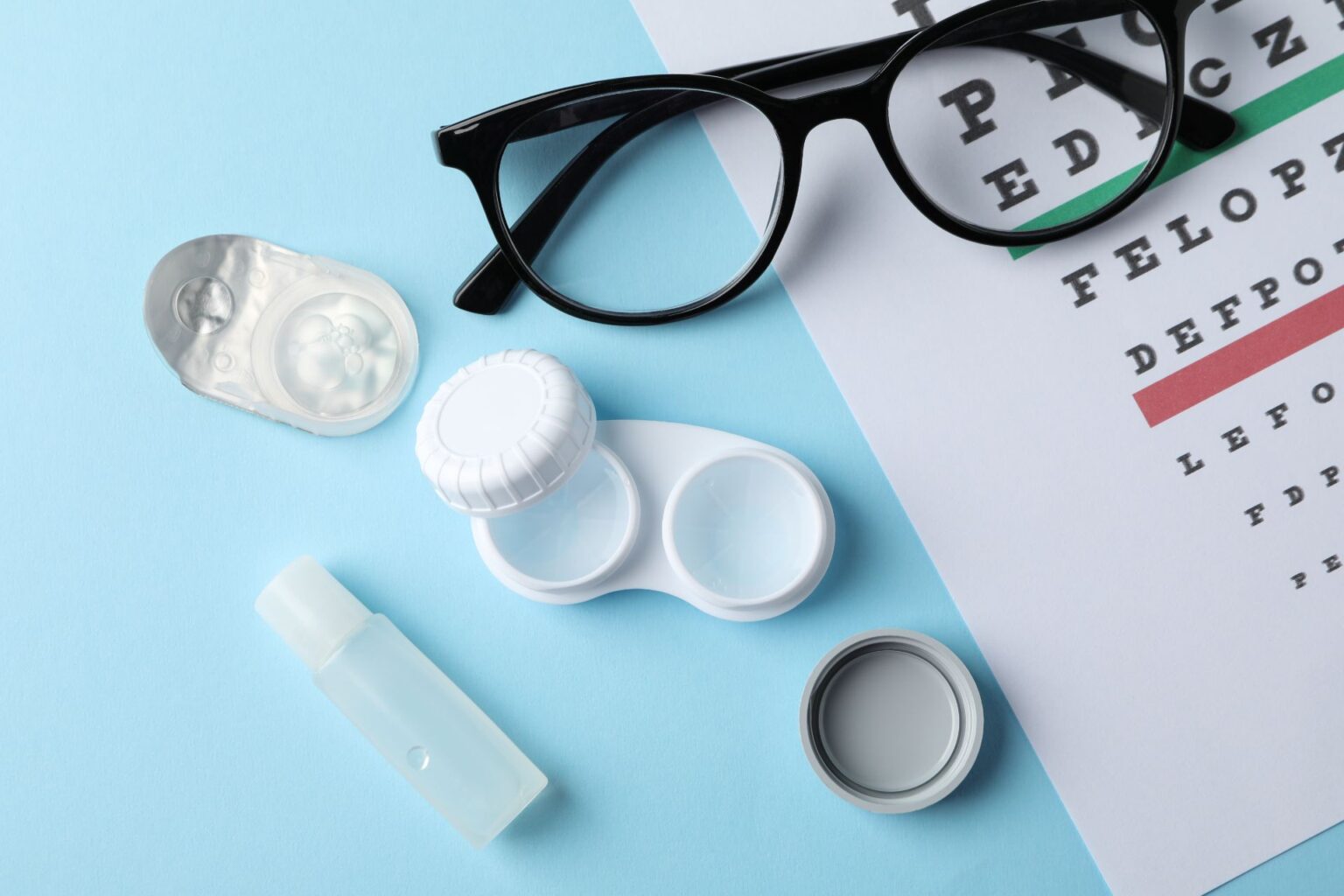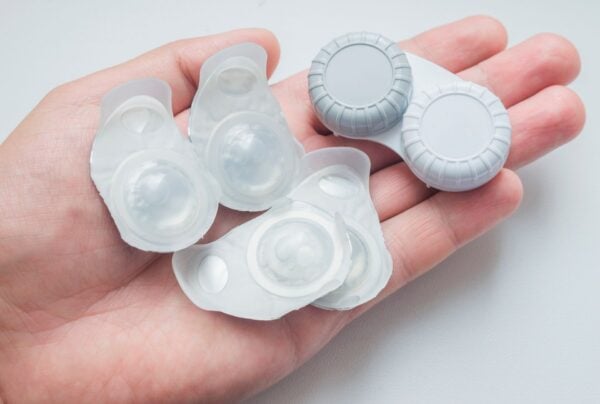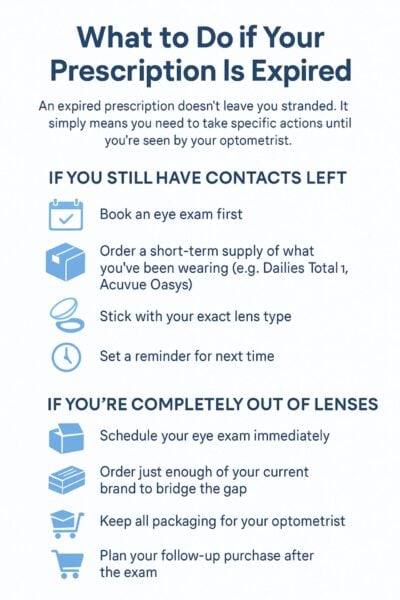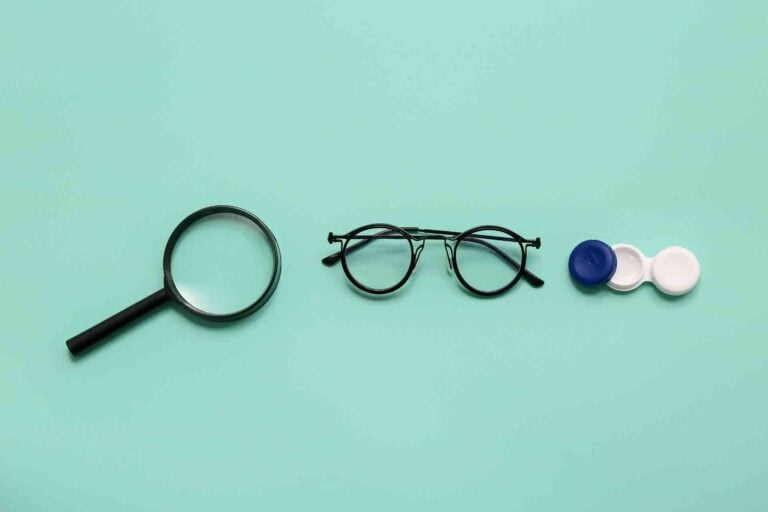
How to Get Contacts with an Expired Prescription in Canada

Paul Slusher
CEO

If you’re running low on contact lenses and just realized your prescription has expired, you’re not alone. Many Canadians find themselves in this situation, usually when they reach for their last pair. So what should you do?
In this guide, we’ll explain why contact lens prescriptions expire, how to get lenses if you’re out, and stay safe while keeping your vision clear.
Why Contact Lens Prescriptions Expire
In Canada, contact lens prescriptions usually expire after one to two years.:
- Your vision can change over time. Even subtle changes in your eyesight can affect how well your contacts work. An exam ensures your lenses still match your current needs.
- Your eye shape and corneal health may shift. The surface of your eye can change shape, which affects how your contacts fit. Poorly fitting lenses can cause irritation or long-term damage.
- Contacts reduce oxygen flow to the eyes. Regular check-ups help ensure your lenses aren’t blocking too much oxygen, which can lead to redness, dryness, or corneal issues.
- Reduce risk of infection. Wearing the wrong lenses, or wearing the right ones beyond their recommended use limits, can raise your chances of eye infections, which may lead to serious complications.
- Silent problems can go unnoticed. Some eye health issues, like early signs of damage or inflammation, don’t cause obvious symptoms at first. Exams catch problems early.
- It’s a legal safety standard. Expiration rules are health regulations designed to protect consumers from preventable harm.
- Contact lens technology evolves. Manufacturers are constantly improving lens comfort, breathability, and moisture retention. A new prescription might offer better options.
- Lifestyle or medical changes can affect lens suitability. Changes like new medications, dry eye symptoms, or even pregnancy can influence what type of lens is safest and most comfortable.
Can You Order Contacts With an Expired Prescription?
In Canada, contact lenses are classified as Class II medical devices under Health Canada regulations. While this classification ensures that manufacturers and importers meet certain safety and licensing standards, it does not require retailers to verify a valid prescription before selling to consumers. That means you can technically order lenses without a current contact lens prescription. That said, most reputable offline and online retailers recommend using a valid, up-to-date prescription.
Wearing contacts without an exam may result in lenses that don’t fit properly, degrade your vision, or lead to preventable eye health problems. A short-term order may help in a pinch, but it’s no substitute for professional care.
When you schedule your eye exam (detailed below) the eye care professional will do what is called a “contact lens fitting”. During a contact lens fitting, you will receive trial contact lenses and try them out, and then return to your eye care professional to give your feedback. A fitting can often take several weeks to work though, but it is very important in terms of getting the right fit and the lenses for you.
As a side note, in the United States, the Contact Lens Consumers Act requires contact lens sellers to verify prescriptions before selling lenses online. If you find a Canadian website that is shipping to the U.S., it’s likely violating Canadian manufacturer agreements, Health Canada guidelines, and possibly U.S. FTC regulations and federal law.
What to Do If Your Prescription Is Expired
An expired prescription doesn’t leave you stranded. It simply means you need to take specific actions until you’re seen by your optometrist.
If You Still Have Contacts Left
Having a few pairs on hand gives you breathing room, but only if you act quickly and use them correctly.
- Book an eye exam right away. Lock in the earliest appointment you can; most clinics can see you within a week or two. If you’re in a pinch, some services offer an online vision exam that may help you renew your prescription temporarily.
- Don’t stretch your supply. Overwearing lenses is riskier than placing a small order with an expired prescription. Order a short-term supply of what you’ve been using, whether that’s daily or monthly lenses, if needed, and replace them according to their instructions.
- Stick with your exact lens type. If you’re wearing toric lenses for astigmatism or multifocal lenses for presbyopia, avoid switching brands without a refitting. Even newer, more adaptable designs like Precision1 or Acuvue Max still work best with a proper exam before changing.
- Set a reminder for next time. Add a calendar alert one month before your prescription’s next expiration date, so you’re never caught off guard again.
If You’re Completely Out of Lenses
Being lens-free can feel urgent, especially if you’re travelling soon or waiting for insurance benefits to renew. If you find yourself out of lenses without a prescription, focus on safe, temporary steps:
- Schedule your eye exam immediately, even if coverage hasn’t reset. Booking now secures the first available slot. Plus, some optometrists also offer a grace period for returning patients, allowing a short-term refill or extending a recent prescription temporarily, especially if you’re only slightly overdue.
- Order just enough of your current brand to bridge the gap. One box of your existing lenses (for example, BioTrue ONEday or Biofinity monthly) is usually all you need. Avoid experimenting with new materials or wear schedules until you’re examined.
- Keep all packaging for your optometrist. Bring your recent lens boxes to the appointment so the doctor knows exactly what you’ve been wearing and can spot any fit or material issues.
- Plan your follow-up purchase after the exam. When your new prescription is ready, place a full order so you’re covered until the next check-up, preferably with at least one pair of backup glasses on hand.
The Do’s and Don’ts of Ordering Without a Current Prescription
Ordering contacts with an expired prescription isn’t ideal, but there are situations where it may be a reasonable short-term solution, as long as you take precautions and follow up with an eye exam. Likewise, there are situations where ordering contacts with an expired prescription simply isn’t worth the risk.
When It’s Okay to Order Without a Prescription |
When You Should Not Order Without a Prescription |
| Your vision hasn’t changed. You’re seeing clearly at all distances with your usual lenses, without any new blurriness or strain. | Your vision has changed, or you’ve experienced visual distortion. Any new blurriness, strain, or trouble seeing clearly can indicate that your prescription is no longer accurate. |
| Your lenses still fit comfortably. There’s no irritation, dryness, or shifting, and your eyes feel normal after a full day of wear. | Your eyes feel irritated. Burning, dryness, or a gritty sensation may mean your lenses no longer fit well and you have an unsuitable prescription, or that your eye health has changed. |
| Your last eye exam was fairly recent. If your prescription expired only a few weeks or months ago, the risk of major change is lower, and you’re less likely to experience issues in the short term. | You’ve had recent eye infections or discomfort. Repeated redness or swelling is a warning sign that should never be ignored. |
| You’re dealing with an urgent situation. Travel, work, school, or a lost or damaged pair of lenses may require a short-term solution. | You haven’t worn lenses in months, or you don’t know the details of your prescription. Your eyes may have changed more than you realize. If you don’t know your brand, base curve, or diameter, don’t guess. |
| You’re not switching brands or lens types. Stick with exactly what was prescribed previously. Don’t experiment with new materials or wear schedules. Switching brands requires quite a bit of visit time and a whole bunch of legwork. | You want to change lens brands or types. Even a small change in base curve or material can affect comfort and vision. |
| You’re wearing a newer, adaptable lens. Lenses like Acuvue Max, Precision1, or Dailies Total1 are designed with advanced materials that tend to be more forgiving (although not completely) if your prescription is just starting to drift. | You wear specialty lenses. Toric, multifocal, or rigid gas permeable lenses require a more precise fit and should always be professionally monitored. |
| You don’t have backup glasses available. If contacts are your only means of seeing clearly, placing a stopgap order may be necessary while waiting for your appointment. | You have a history of eye conditions. If you’ve had corneal ulcers, keratoconus, or chronic dry eye, don’t take chances. |
| You’re in communication with your eye doctor. If your optometrist has confirmed there’s likely no issue continuing your usual lenses temporarily, that can help guide your decision. | You’ve had recent health or medication changes. Certain prescriptions (like allergy meds or acne treatments) can affect tear production and lens comfort. |
Even if you check all the boxes in the left column, remember: these are short-term exceptions, not long-term workarounds. Always follow up with a proper eye exam as soon as possible.
Tips for Managing Your Contact Lens Supply
 Keeping your contact lens prescription up to date is only part of the equation. Managing your supply well can help you avoid last-minute orders, risky decisions, and unnecessary eye strain. Here’s how to stay ahead of the game:
Keeping your contact lens prescription up to date is only part of the equation. Managing your supply well can help you avoid last-minute orders, risky decisions, and unnecessary eye strain. Here’s how to stay ahead of the game:
- Track your wear schedule. Whether you wear daily or monthly lenses, stick to the recommended replacement cycle.
- Reorder when you open your last box. This gives you a buffer so you’re not scrambling to find lenses with an expired Rx.
- Keep backup glasses on hand. They’re essential in case of delays, discomfort, or lost lenses.
- Set reminders for your next exam. Most prescriptions last one to two years, so set an alert four to six weeks before it expires.
- Know your lens details. Brand (Acuvue Oasys for Astigmatism or Proclear 1 Day), base curve, and diameter should be noted or saved from the box.
- Avoid overstocking. Don’t bulk order contact lenses if your prescription is nearing expiration.
Keep Your Eyes Safe, Even With an Expired Contact Lens Prescription
At Contacts For Less, we strongly recommend you buy contact lenses with a valid contact lens prescription. That’s the best way to protect your eye health, ensure a proper fit, and catch any issues early. But if your prescription has expired and your appointment is still a few days away, we’re here to help you stay on track.
You can place a short-term order for the lenses you’ve already been wearing, like Air Optix Night & Day monthly lenses or Dailies AquaComfort Plus, without uploading a prescription. This option helps you get through until your contact lens exam, but we always suggest treating it as a temporary step, not a replacement for professional care.
We carry a wide selection of trusted brands and lens types, and every order helps support environmental causes. Contacts For Less donates 51% of profits to organizations working to protect the planet, so when you purchase contact lenses from us, you’re not just taking care of your eyes; you’re contributing to something bigger.


 US website
US website



